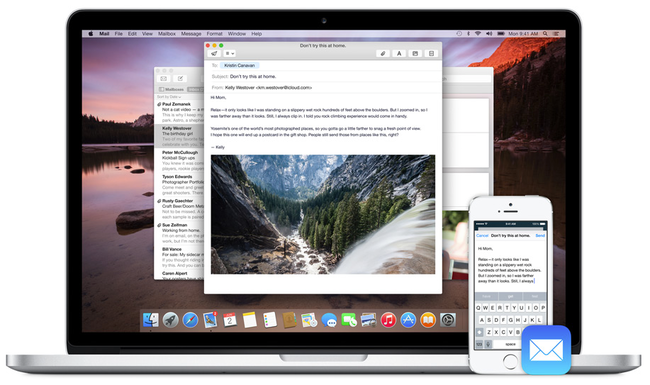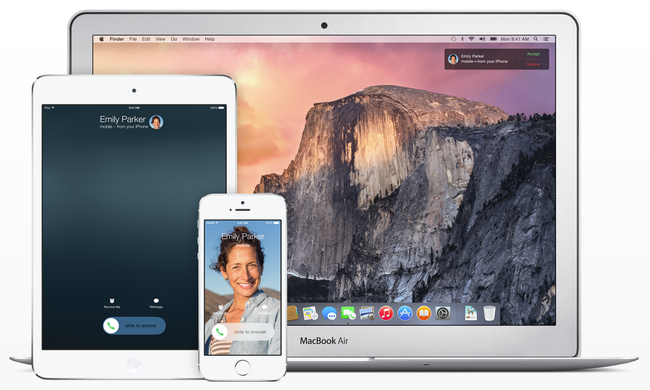iOS 8 moves the smartphone to the centre of computing
Apple’s WWDC this year was monumental, but not because the company redesigned OS X or released a shiny new version of iOS. It was a game-changing unveil because Apple has finally acknowledged that the centre of computing now revolves around the phone.
A new technology called Continuity provides a seamless experience when moving from the Mac to the phone/tablet. A few examples of how Continuity works are important to illustrate how powerful this is:
- If you’re writing an email on your Mac and you need to quickly head out, you can swipe the mail icon that appears on the lower left of your iPhone or iPad and it opens in Mail where you left off
- Working on a spreadsheet or word document? Same deal. Just swipe up on the icon.
- Browsing an interesting website and want to move to the iPad? Again, just swipe the icon.
- You get an incoming cellular call on your iPhone, which appears on your Mac and iPad and can be answered there
- Your SMS messages are synchronised to your computer and iPad, so you can send traditional messages via non-cellular devices
- Automatically make a wifi hotspot when you have no wifi on your Mac
Missed opportunity #
For years, I thought Microsoft would get to doing this first and I was hopeful that it would. I used Windows Phone for two years in the hope of a seamless experience with my PC, but the company utterly failed.
It actually looked like it was going to pull it off with the release of Windows 8 but failed to deliver such functionality, despite supposedly sharing the same core across Windows Phone and Windows now. It should have been easy, but Microsoft still hasn’t done it.
Many have claimed this isn’t as revolutionary as it appears on the surface, because you can kind of do it already. Well, yes, you sort of can. Consider how ‘integration’ works in Microsoft’s world at the moment:
- Save it to your Onedrive
- Grab your phone, find the Office app
- Figure out where you saved it in Onedrive
- Open the document
- Find the place you were editing
Entirely doable, but far more complex than it needs to be. Apple has looked at this exact problem and removed almost all of these superfluous steps. With Continuity in iOS 8, these are the steps:
- Swipe up on the Pages icon on the lock screen
Our smartphones are the most important computing device we have today and are used far more than any other piece of technology we own, but until now they’ve been analogous to computers, barely interacting with them in a meaningful way and operating in their own silos.
Remove the friction #
The future of computing revolves around tight-knit smartphone experiences that integrate with the other devices (PC, tablet) that we use, to remove the friction to getting things done. Why should the smartphone operate independently when it can be integrated with the PC OS to allow use of its features without touching it? Why has it taken so long for a software builder to realise this?
It’s surprisingly common for users to email links to themselves for browsing on your phone or tablet, but why? The disconnect between phone and computer has been vast until now, meaning that the path of least resistance to getting a link on your mobile device has been to just send a message to yourself. Ridiculous.
Apple’s Continuity shows that it understands this problem better than anyone else right now; the smartphone is the centre of our computing universe, therefore it should be fully integrated with the company’s other platforms, removing all the friction of moving tasks between Mac and iPhone/iPad.
Despite what many say, the web as we know it is dying and rapidly being replaced by a series of native applications and Continuity will help this trend continue. Web apps simply cannot be this integrated or easy to use across operating systems, nor can they provide such a smooth handoff experience.
We have had these tiny supercomputers in our pockets for some years now and we’re finally starting to see them integrated into our traditional devices in a meaningful, powerful way.
Continuity makes the OS X + iOS story even more compelling. I can imagine that this will help Macs sell even faster, alongside the iPhone.
We’re on the precipice of the smartphone becoming the centre of our computing universe and integrating with laptops and tablets seamlessly. Our smartphones are now the conduit for almost everything we do.
Now that Apple’s built it, the other software makers will follow.

